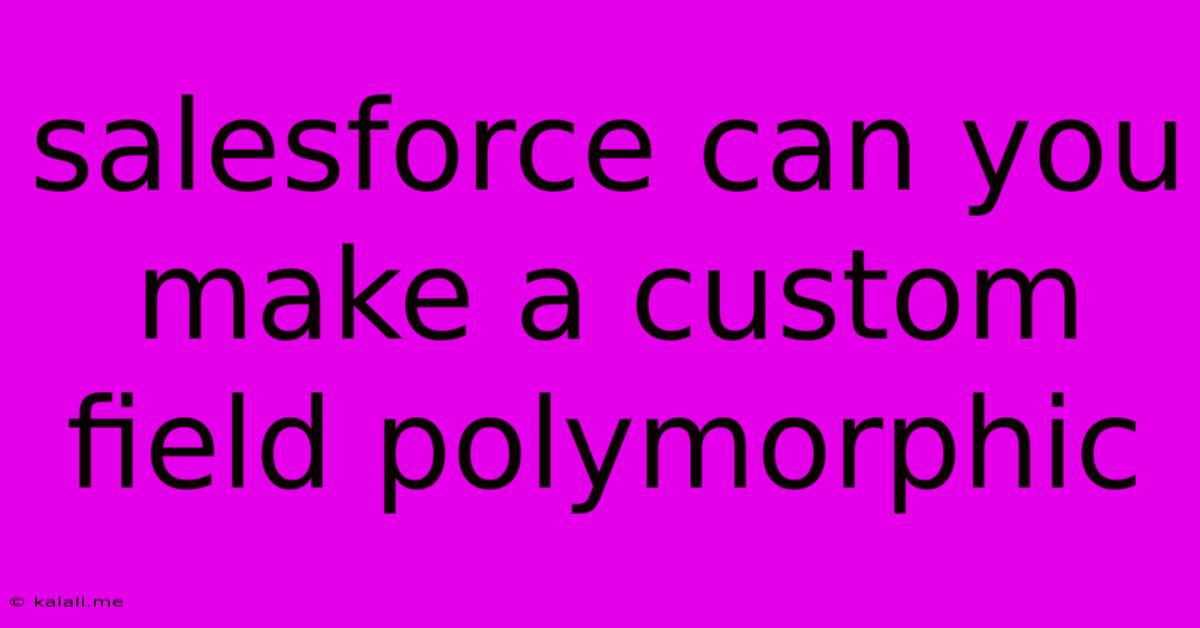Salesforce Can You Make A Custom Field Polymorphic
Kalali
May 24, 2025 · 3 min read

Table of Contents
Salesforce Polymorphic Custom Fields: Extending Data Flexibility
Salesforce's power lies in its flexibility, but sometimes even its standard features need extending. One area where customization shines is handling diverse data types within a single field. This is where polymorphic custom fields come into play, offering a powerful way to store different data types within a single field, enhancing your Salesforce data model significantly. This article will explore what polymorphic custom fields are, why you might need them, and how you can effectively implement them.
What are Polymorphic Custom Fields?
A polymorphic custom field, in essence, allows you to store various data types within a single field. Instead of creating separate fields for different data types (e.g., a text field for one type of information and a number field for another), a polymorphic field allows you to adapt and store data dynamically. This is particularly useful when you have a master-detail relationship where the detail records have varied attributes. Think of a "Related Item" field that could hold details about a product, a contact, or an opportunity, all within the same field. This eliminates the need for numerous, specific fields.
Why Use Polymorphic Custom Fields?
-
Data Consolidation: Reduces redundant fields and simplifies data management. Instead of multiple fields for different data types, you have one field that adapts to the data type.
-
Flexibility and Scalability: Easily accommodates future data types without modifying your schema. This is crucial for applications requiring flexibility and scalability.
-
Improved Data Integrity: Because the data type is controlled, this approach aids in maintaining data integrity and reduces potential errors compared to storing diverse data in a single text field.
-
Simplified Data Modeling: Reduces database complexity and enhances the overall efficiency of your data model.
Implementing Polymorphic Custom Fields in Salesforce
Unfortunately, Salesforce doesn't offer a direct "polymorphic custom field" feature. However, you can achieve this functionality through clever use of existing features. The most common and effective approach involves the following:
-
Lookup Field: Create a lookup field on your custom object that points to a "Polymorphic Object." This acts as the master record.
-
Polymorphic Object: Design a separate custom object (the "Polymorphic Object") with a field to identify the data type. For example, a field called
RecordTypecould have picklist values such as "Product," "Contact," or "Opportunity." -
Additional Custom Fields: Add custom fields to the Polymorphic Object to capture the specific data for each record type. For example, for "Product," include fields such as
ProductNameandProductPrice. For "Contact," you could addContactNameandContactEmail.
Example: Tracking Related Items
Let's say you have an object called "Case" and you want to track related items. Instead of having separate fields like "Related Product," "Related Contact," and "Related Opportunity," you would:
- Create a lookup field on the Case object that points to a custom object called "Related Item."
- The "Related Item" object would have a field named
RecordType(Picklist: Product, Contact, Opportunity). - Add fields specific to each RecordType (e.g.,
ProductIdandProductNamefor Product type,ContactIdandContactNamefor Contact type, etc).
When a case is related to a product, you create a "Related Item" record with RecordType as "Product" and populate the product-specific fields. This keeps all related items organized within a single structure.
Best Practices
- Clear Naming Conventions: Use clear and descriptive names for fields to ensure understanding and maintainability.
- Proper Validation Rules: Implement validation rules to ensure data integrity, preventing inappropriate data entry.
- Well-Defined Record Types: Utilize record types within the Polymorphic Object to enforce consistent data entry for different record types.
- Careful Planning: Thoroughly plan your data model before implementing polymorphic fields to ensure they align with your application's needs.
Conclusion
Although Salesforce doesn't have built-in polymorphic custom fields, you can create this powerful functionality through strategic use of lookup fields, custom objects, and careful data modeling. This approach allows for increased flexibility, scalability, and data integrity in your Salesforce applications. By following the best practices outlined above, you can implement effective polymorphic custom fields, expanding the capabilities of your Salesforce platform.
Latest Posts
Latest Posts
-
How Do You Beat Stage 9 On Bloxorz
Jul 06, 2025
-
What Is 1 2 Equivalent To In Fractions
Jul 06, 2025
-
How Do You Say Pork In Spanish
Jul 06, 2025
Related Post
Thank you for visiting our website which covers about Salesforce Can You Make A Custom Field Polymorphic . We hope the information provided has been useful to you. Feel free to contact us if you have any questions or need further assistance. See you next time and don't miss to bookmark.